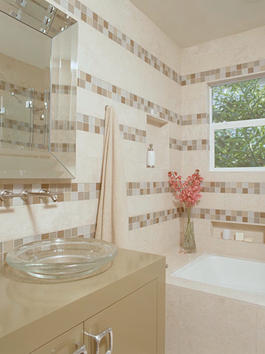Are you a homeowner who wishes that your home was a little bit different, more…
Hidden Spaces in Your Small Bathroom

Creating space in your small bathroom means looking in unexpected places and making bold choices.
Designing a small bathroom can be a big challenge, but it's no time to be timid. Creating space, or even the illusion of space, often calls for confident paint, wallpaper and tile choices, not to mention occasionally punching a hole in the wall or hiking a vanity cabinet off the floor. Los Angeles designer Sarah Barnard shares some smart strategies that can help you find the hidden space in your small bathroom.
Keep a Simple Color Palette
"Using multiple shades of the same base color can visually expand a teensy bathroom," Barnard says. This bath appears much roomier than its 57 square feet by employing a simple, warm beige color scheme carried out in tile that goes all the way to the ceiling.
Note the pattern created in the tile — while you might avoid horizontal bands on a sweater because they make you look wider, you should embrace that plumping effect in the bathroom. "Narrow horizontal stripes make maximum impact with minimum square footage," Barnard says.
To lighten the room even further, you can choose a shiny metallic tone for a band of tile, an art object or your mirror's edge, because reflected light gives the illusion of more space. But don't go overboard with glitz. "It can look dated very quickly," Barnard says.
Another clever space-boosting touch in this bath is placing the sink off center rather than in the middle of the countertop, creating more usable surface to the left for toiletries.
The four walls of your bathroom are a box, and you have permission to think outside them. In fact, you can make holes in them. "Making use of the space inside the walls is one of the best ways to maximize storage in a small bath," Barnard says. This bath captures interior wall space for a shampoo and soap niche.
If you're working with an existing bath rather than remodeling or adding, you may not want to disturb a tiled bath or shower surround. But a space over a toilet or sink that's covered in drywall may present an opportunity for chic, seamless recessed shelving.

Go Vertical
Floor-to-ceiling tile emphasizes every inch of height you have and makes a stunning presentation. Subway tiles, mosaic tile or diamond-shaped tile (as in this bath) are good choices, Barnard says, but stay away from big squares, which can feel heavy.

Search for environment-friendly wallpaper choices at specialty retailers such as Farrow & Ball and Tri|Kes.

A nearby closet or laundry room can be the source of the space you need to build a new bath or make an existing one more comfortable. "My client wanted a second bathroom for her tiny beach bungalow but was limited by a tight budget," Barnard says. "We moved the washer and dryer to the kitchen and took over the laundry room to arrange this spa-inspired bath."
Out of view in this bathroom photo is another smart choice that creates a roomy feel: the vanity is mounted to the wall, leaving 16 inches of empty space between the bottom of the cabinet and the floor. Not only does it create the illusion of more square footage, but leaving at least nine inches of clearance makes the bathroom wheelchair-accessible.

Splurge on a Luxe Finish
The art of fooling the eye sometimes depends on distraction. A well-chosen high-end touch, such as the combo of the onyx vessel sink and pillowed onyx tile in this powder room, can make such a dramatic effect that you won't notice the size of the room.
In a tight space, it's extremely important to consider visual balance. Too much art on the wall or too many decorative items on a shelf and the room will feel cramped. "For a healthy mental environment, you need to keep at least 40% of the room as negative space," Barnard says. "That means empty walls. No art, no towel racks, no cabinets."
In this bath, for example, a quiet, soothing tile rather than a busy pattern counts as negative space. A mirrored medicine cabinet in addition to the over-sink mirror produces the illusion of depth, but the lion's share of wall space is free of ornament and restful to the eye.

HGTV. Hidden Spaces in Your Small Bathroom, [Online]. Web address: http://www.hgtv.com/bathrooms/hidden-spaces-in-your-small-bathroom/index.html (Page consulted on July 11 2011)
Lock In Your $1500 Savings. Schedule Today.
Find A Location Near You













